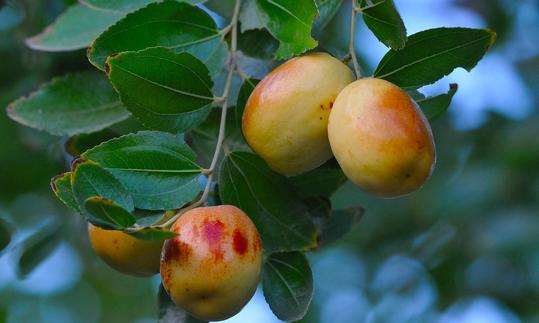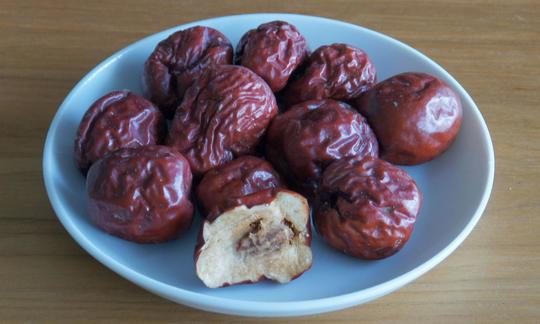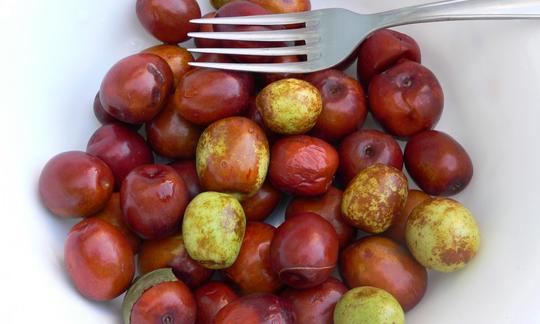Table of contents
The Chinese jujube is a stone fruit that tastes similar to an apple when eaten raw and preferably in organic quality. In addition to its use in cooking, it is often used in traditional Chinese medicine.
Use in the kitchen
Chinese jujube ( Ziziphus jujuba) is also known synonymously as azufaifa, breast berry or Chinese date. It has a sweet and sour aroma. When fresh, it tastes very similar to apples and can be prepared in a similar way. It can be eaten raw, dried, steamed or pickled in alcohol. Drying results in a more intense and sweeter taste, but sometimes also a harder skin. This can be easily removed by boiling it covered in water for ten minutes and then letting it cool. When dried, the jujube looks and tastes similar to a date. The fresh fruit is often made into liquor, jam or puree. When chopped finely, it goes well with nuts (e.g. almonds, pistachios or walnuts), candied fruit, compotes, vegan yoghurt, muesli and smoothies. What kind of jujube recipes are there? Recipes with azufaifas, as the fruits are also called, are very different; they taste great with coconut, vegan cream cheese, honey and oranges, but can also be combined with kale, onions, olive oil and a pinch of salt andpepper. Sautéed, their sweet aroma perfectly complements sweet peppers, eggplant or zucchini and, lightly roasted, can be served with chopped root vegetables (e.g. radishes, carrots, beetroot or celeriac), apples and pears.
Mashed into a puree, the berries can be used as a spread or filling for pastries, cakes and muffins. You can also use the fruit for baking. Their natural sweetness means they can replace some of the sugar or other sweeteners. In Asian cuisine, jujube is also used for soups (e.g. for the Korean chicken soup Samgyetang), sauces, stews and teas.
Vegan recipe for smoothie with Chinese jujube
Ingredients (for 1-2 servings): 120 g Chinese jujube (organic), 120 g bananas, 60 g strawberries, 120 ml almond milk, 60 ml water.
Preparation: After removing the seeds from the jujube, put all the ingredients in a blender and mix until the smoothie is smooth. Enjoy the vegan smoothie immediately.
Tea preparation
ingredients (for 4 cups): 6 Chinese jujubes (dried), ½ cup goji berries (dried), 1 piece of ginger (approx. 5 cm), 1 l water.
Preparation: Soak dried jujube fruits briefly in water (this makes cutting easier), then halve and remove seeds with a knife. Cut ginger into thin slices. Mix all ingredients in a small pot with water and boil for ten minutes or until the tea turns a pale amber color. Strain the fresh jujube tea before serving. Drink the tea hot. Leftovers can be stored in the refrigerator for up to ten days and reheated as needed or enjoyed cold.
Vegan recipes with Chinese jujube (raw) can be found under the note: " Recipes that have the most of this ingredient ".
| Not only vegans or vegetarians should read this: Vegans often eat unhealthily. Avoidable nutritional mistakes. |
Purchasing - Storage
Chinese dates tend to be difficult to buy in Europe. For dried or fresh specimens, Asian shops, health food stores or online retailers offer the best prospects of buying them. If possible, look for organic quality. Major retailers such as Coop, Migros, Denner, Volg, Spar, Aldi, Lidl, Rewe, Edeka, Hofer and Billa do not usually offer the fruit. Nor do organic supermarkets such as Denn's Biomarkt and Alnatura.
The availability of Chinese jujube varies depending on the size of the store, catchment area, etc. Our recorded food prices for the DA-CH countries can be found above under the ingredient image - and by clicking you can see their development at various suppliers.
Storage tips
The fruit can be kept for a long time in a cool, dry place. For a period of several months, storage in the refrigerator is recommended.
Ingredients - Nutritional values - Calories
100 g of raw Chinese jujube provides 79 kcal of energy. This consists of 0.2 g fat, 20 g carbohydrates and 1.2 g protein. 1
The vitamin C content is 69 mg, which covers 86% of the daily requirement. Lychee (72 mg/100g) and papaya (61 mg/100g) have similarly high values. Sea buckthorn berries, for example, have particularly high amounts of vitamin C (450 mg/100g). 1
100 g of the raspberry contains 250 mg of potassium. This covers 13% of the daily requirement. Apricots (259 mg/100g) and cinnamon apples (247 mg/100g) have similar values. Medjool dates have a particularly high potassium content (696 mg/100g). 1
Vitamin B6 (pyridoxine) is present at 0.08 mg/100g (6% of the daily requirement). 100 g of gooseberries and lemons contain the same amount. Vitamin B6 is found in many foods. Good sources are nuts, pseudo-cereals, grains, herbs, pulses and vegetables. Sunflower seeds (1.3 mg/100g) and hazelnuts (0.56 mg/100g) have particularly high levels. 1
Ziziphus jujuba contains high amounts of phytochemicals such as phenolic acids, flavonoids and ellagic acid, which have strong antioxidant properties. 2 These plants contain a total of 64 alkaloids, 16 glycosides and flavonoids, 14 terpenoids and other phytochemicals, each component having different and complex properties. 3
The complete ingredients of Chinese Jujube (raw), the coverage of the daily requirement and comparison values with other ingredients can be found in our nutrient tables. In the article Nutrients explained you will get a detailed insight into the topic.
Health Effects
Overall, the jujube fruit contains a large number of functional substances with a variety of physiological effects. Apart from providing nutrients to the body, there are few clinical studies on the significant effects of jujube, which limits the application of its active components in clinical medicine. In many experiments, researchers have only been able to demonstrate the biological effects of the dietary components in cell models at supraphysiological intracellular concentrations, which are usually higher than those available in the human body. In addition, the bioavailability of most nutrients may be reduced after digestion and absorption by the human digestive tract. Thus, results from epidemiological studies and human intervention studies are often lacking. Therefore, an in-depth analysis of the metabolic pathways and pharmacokinetics of the active components of jujube is crucial for future clinical applications. Although many TCM prescriptions containing jujube are currently used to prevent and treat diseases, human studies are still needed to clarify the correspondence between the content of active components and the biological functions of jujube and the molecular mechanisms. These can also provide a safe, scientific and rigorous theoretical basis for the application of jujube as a functional food. 4
Hypothetical health benefits associated with jujube consumption (as demonstrated by cell studies or animal models) include its role in fighting cancer, inhibition of foam cell formation in macrophages (white blood cells), anti-inflammatory, anti-obesity, immune stimulation, use in anemia, 5 neuroprotective properties 6 and antioxidant, hepatoprotective and gastrointestinal protective effects. 2
Dangers - Intolerances - Side Effects
There are no known dangers, intolerances or side effects associated with the consumption of jujube fruits. 7,8
Folk medicine - natural medicine
The term "breast berry" serves as a pharmaceutical synonym for the Chinese jujube and shows that the fruit was used in folk medicine for colds and respiratory diseases; mainly in dried form as a tea. Hence the name "breast tea". 8
Traditional Chinese Medicine ( TCM) lists it as a medicinal plant in the Shennong Bencao Jing (“Shennong Classics of Traditional Chinese Pharmacology”; 200 BC). In the list of “valuable plants” compiled there, the milk berry is described as having a strengthening effect and as being non-toxic to humans. It is said to have analgesic, calming and sedative healing effects, among other things, and is used for gastrointestinal complaints, digestive disorders, restlessness, sleep disorders, heart failure and circulatory weakness, and anemia. 8
Recent studies have shown that, in addition to the fruit, almost all parts and extracts of Z. jujuba have significant pharmacological effects and are often used in natural medicine as complementary medicines to treat a variety of diseases. The roots of the Ziziphus genus are used in India to treat headaches, nausea and coughs. Chronic diarrhea and dysentery (inflammation of the intestine caused by bacteria) are treated with the bark. The boiled leaves are used to clean corpses before burial and to treat obesity and weight loss. The seed extracts can be used to treat eye problems and leucorrhoea. Many Indian ethnic groups use the fruit to treat fever, diabetes and vomiting. Powdered leaves and bark have long been used in India as wound dressings. 3
Ecological footprint - animal welfare
The ecological footprint of a food depends on various factors. The type of agricultural production (conventional vs. organic), seasonal, regional or domestic production or import by truck, ship or plane, different types of packaging and whether the goods are fresh or frozen all play a decisive role. 9
Despite intensive research, we were unable to find any data on the CO2 balance. Information on the water footprint is also very rare. A study examined data from 2003 to 2015 from the Chinese growing region of Tianshan, which accounts for around 37.2% of the global jujube market. The researchers concluded that blue water (artificial irrigation) makes the largest contribution to the components of the jujube water footprint, at more than 70%. The share of grey water (contaminated by production) in the total water footprint used was quite small, at less than 10%, and the remaining 10 to 15% was green water (rainwater). 10 Unfortunately, the study does not provide any information on the exact water consumption in liters per kg of fruit produced.
For detailed explanations of various sustainability indicators (such as ecological footprint, CO2 footprint, water footprint), see our article: What does the ecological footprint mean?
Worldwide occurrence - cultivation
of breast berries originally come from China and grow there mainly on hills and in the mountains up to 1700 meters above sea level. 2000 years ago the fruit had spread throughout China. Large commercial jujube cultivation areas were created and the jujube had developed into one of the five most important fruit trees in China, alongside peach, apricot, plum and chestnut. Around the year 0 the fruit reached Japan and Korea and via the old Silk Road to Central Asia and Europe. Today it is widespread in at least 47 countries on all continents, except Antarctica. 11
China produces and exports more jujube than any other country in the world. It is estimated that more than 90% of the world's jujube products come from China. 12
Found in the wild
Ziziphus species are found in tropical, subtropical and cold areas of the world. Z. jujuba is domesticated in most cases, but also occurs in the wild. Although the tree tolerates fluctuations in rainfall and temperature, it requires hot weather and sufficient water to produce good fruit. This allows the jujube to grow in desert areas or in the mountains where groundwater is available throughout the summer. 3
There is a possibility of confusion with the jojoba shrub ( Simmondsia chinensis), which is, however, native exclusively to the North American continent. 13
Cultivation - Harvest
Z. jujuba has reportedly been cultivated for 5000 years, with the main growing areas being the subtropics of Asia, mainly China. 14 Jujube production in China is concentrated in the provinces of Hebei, Xinjiang, Shandong, Shanxi, Shaanxi and Henan. Dry farming is the main cultivation method due to the severe shortage of water for irrigation. Over 40% of the crop is grown in China. However, other countries such as Egypt, Iran, Saudi Arabia, Algeria and Iraq have shown growing interest in cultivation. 12
Fresh consumption of the fruit is becoming increasingly popular both in China and abroad. Jujube fruit for export is harvested between August and October, with the optimum harvest time being September. 15 The jujube industry in Western Australia is predicted to have a prosperous future as it grows well in many areas of the country and offers an opportunity to supply the Southeast Asian market in particular due to possible contra-seasonal production compared to the northern hemisphere. 12
Further information
Ziziphus jujuba belongs to the buckthorn family (Rhamnaceae). Related species are Z. mauritiana, Z. spina-christi, Z. lotus and Z. jujuba var. spinosa. The Ziziphus tree can grow up to 10 meters tall and has brown to gray-brown bark. The leaves of the deciduous tree are long, elliptical and turn golden yellow in autumn. 16
Alternative names
Jujube is also called Chinese date, red date, (red) jujube or azufaifa. In English the fruit is called Chinese date, Chinese jujube, jujube or red date and in Chinese "Da Zao" and "Hong Zao".
Bibliography - 16 Sources (Link to the evidence)
| 1. | USDA United States Department of Agriculture. |
| 2. | Gao QH, Wu CS, Wang M. The jujube (Ziziphus jujuba mill.) Fruit: A Review of Current Knowledge of Fruit Composition and Health Benefits. J Agric Food Chem. 2013;61(14):3351–3363. |
| 3. | Agrawal P, Singh T et al. An updated review of Ziziphus jujube: Major focus on its phytochemicals and pharmacological properties. Pharmacological Research - Modern Chinese Medicine. 2023;8:100297. |
| 4. | Lu Y, Bao T et al. Research advances in bioactive components and health benefits of jujube (Ziziphus jujuba Mill.) fruit. J Zhejiang Univ Sci B. 2021;22(6):431–449. |
| 5. | Chen J, Tsim KWK. A Review of Edible Jujube, the Ziziphus jujuba Fruit: A Heath Food Supplement for Anemia Prevalence. Front Pharmacol. 2020;11:593655. |
| 6. | Chen J, Liu X, et al. A Review of Dietary Ziziphus jujuba Fruit (Jujube): Developing Health Food Supplements for Brain Protection. Evidence-Based Complementary and Alternative Medicine. 2017;2017:3019568 |
| 7. | Aafi E, Reza M, Mirabzadeh M. Jujube (Ziziphus jujuba mill. (Rhamnaceae)): a review on its pharmacological properties and phytochemistry. Tradit Med Res. 2022;7(4):38. |
| 8. | Siedentopp U. Heilpflanze chinesische Dattel. Deutsche Zeitschrift für Akupunktur. 2008;51(3):58–61. |
| 9. | Reinhardt G, Gärtner S, Wagner T. Ökologische Fussabdrücke von Lebensmitteln und Gerichten in Deutschland. IFEU Institut für Energie- und Umweltforschung Heidelberg. 2020:1-22. |
| 10. | Yu J, Long A et al. Incorporating the red jujube water footprint and economic water productivity into sustainable integrated management policy. Journal of Environmental Management. 2020;269:110828. |
| 11. | Liu M, Wang J et al. The historical and current research progress on jujube–a superfruit for the future. Hortic Res. 2020;7(1):119. |
| 12. | Shahrajabian MH, Sun W, Cheng Q. Chinese jujube (Ziziphus jujuba Mill.) – a promising fruit from Traditional Chinese Medicine. AUPCStudiaNaturae. 2020;5:194–219. |
| 13. | Agarwal S, Kumari S, Khan S. Jojoba (Simmondsia chinensis). In: Farooq M & Siddique KHM, Hrsg. Neglected and Underutilized Crops. Future Smart Food. Elsevier; 2023: 757–779. |
| 14. | Shahrajabian MH, Khoshkharam M et al. Jujube, a super-fruit in traditional Chinese medicine, heading for modern pharmacological science. JMPS. 2019;7(4):173-178. |
| 15. | Zhang Q, Wang L et al. Variations of the nutritional composition of jujube fruit (Ziziphus jujuba mill.) during maturation stages. International Journal of Food Properties. 2020;23(1):1066–1081. |
| 16. | Pflanzen-Lexikon com: Chinesische Jujube Ziziphus jujuba Mill. |












Comments